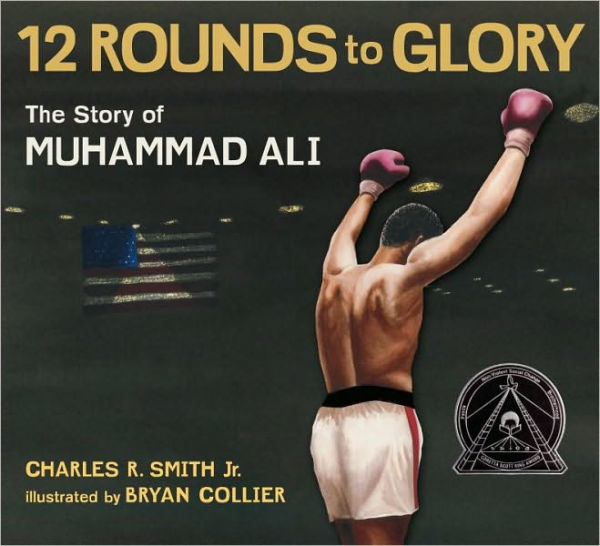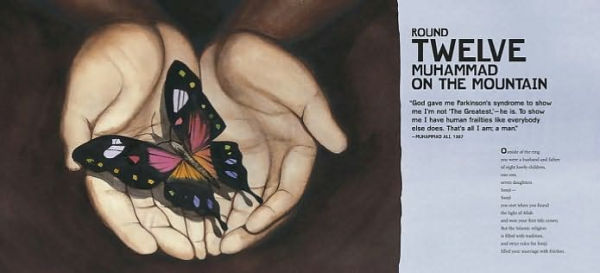It is the text by Charles R. Smith Jr. that illuminates the dazzle and daring of Ali, and ultimately the spiritual calm. He writes in a soft-rap second person singular, suggesting a poetry-slam letter of thanks for a life that has enriched us. This is a book that fulfills the mission of engaging readers until they are ready for the ever expanding adult shelf of Aliology in all its nuance and spin.
—The New York Times
This paean to the legendary pugilist offers a multifaceted portrait of the fighter as brazen, charitable, fiercely competitive and deeply spiritual. Smith's (I Am America) poetry recalls the rhymed, rhythmic chants Ali used to inflate his image and taunt opponents ("Fighting opponents and hatred/ with two glowing gloves,/ you spoke your mind freely/ while radiating love"). Each of the dozen chapters represents a period in Ali's life, from his birth through his boxing years, his conversion to Islam and retirement and diagnosis with Parkinson's. The fight scenes don't sugarcoat the violence: "when his rock-solid fist,/ released from way back,/ slingshot your cheek/ and broke your jaw with a crack." While some rhymes feel forced ("Each victory inching you/ closer to Sonny/ Liston, the champion,/ for title and money"), Smith's chronicle of Ali's life is nonetheless remarkable in its use of a compact, verse format to convey a great deal of biographical material. Collier's (Lift Every Voice and Sing) dynamic collages capture the emotional weight of both Ali's triumphs and failings; memorably, he depicts the fighters' blows as small ball bearings with fiery tails that radiate outward, heightening the sense of impact. Bold quotes from Ali and others seem to shout across the spreads and, along with Collier's artwork, provide a visual respite from the lengthy columns of verse. This unique and thorough tribute to a complex American hero should readily enthrall those seeking a less conventional biography. Ages 10-up. (Dec.)
Copyright 2007 Reed Business Information
This slim, unique work of art profiles the life of Muhammad Ali from his birth in 1942 until his present-day battle with Parkinson's Disease. There is not much in-depth information here, but many of Ali's direct quotes and anecdotes are relayed. Much text is devoted to Ali's various fights, especially the ones against George Forman and Joe Frazier. His strong Islamic faith is credited with many of his successes as well as his opposition to the Vietnam War. Written in verse, the sing-song rap format might not appeal to some. The strength of this book lies in the work of the illustrator. Every page has wonderfully bold-colored, collage-style artwork enhancing the text. It is cataloged as a sports book, but it works better as a lovely picture book. There is a time line at the end of the book. Walter Dean Myers's The Greatest (Scholastic, 2000/VOYA February 2001), is a more moving tribute to the life of Muhammad Ali. Reviewer: Kathie Fitch
Lyrical verse with the cadence of rap weaves and bops its way through the life of Muhammad Ali. In twelve glorious rounds his life is measured, from his humble beginnings as Cassius Clay, to his youthful introduction to boxing, through all his title bouts and the triumphant moment when with hands shaking from Parkinson’s, Ali lifted his torch to the Olympic flame. The quintessential showman is presented here with all his bravado and stinging taunts at opponents Sonny Liston and Joe Frasier. But we are also shown a man deeply committed to his Islamic faith and one who firmly stands up for what he believes in his refusal to be a combatant in the Viet Nam war. In his celebration of the man who is a legend, the author does not shy away from writing about the two final years of Ali’s career that saw back-to-back defeats, or discussing the disease that is now wracking the body of the “Prince of Pugilism.” Handsome watercolors and collages are filled with energy and power and dramatically enhance this remarkable biography of a flawed man, but one still deserving to be called “the greatest.” Facial expressions are strong and emotive while the athleticism of the boxer is revealed in every fight scene. Onomatopoeic words add punch and vigor. The dense verse may be intimidating at first but the persistent readers will be rewarded. Readers who have enjoyed Champion: The Story of Muhammad Ali by Jim Haskins (2002) may be ready for this. It has been named a Coretta Scott King Honor Book for 2008. Reviewer: Beverley Fahey
Gr 5 Up
Smith is best known for his high-energy poetry celebrating basketball and other sports, and this biography is his most ambitious undertaking yet. Rap-style cadences perfectly capture the drama that has always surrounded this boxer's life: "Louisville Lip leaps to life/just a few short years/after your first pro fight./Braggin'/and boastin'/and callin' the round,/signifyin'/how your opponent would go down." From Ali's childhood as Cassius Clay, to the realization that even an Olympic gold medal would not shield him from racial injustices, to a career that included three heavyweight titles, and his life after retirement, Smith skillfully weaves together the threads of the boxer's life, including his Muslim faith and his run-ins with the American government during the Vietnam War. Each chapter, or "round," represents a specific period, and selected quotes from Ali and voice-overs from announcers provide a "you are there" feeling. Collier's compelling watercolor collages with their brown overtones beautifully portray Ali's determination and strength. Each spread seamlessly melds powerful artwork and text in a way that transcends what either could be on its own. The thorough recounting of Ali's life, along with back matter that includes a time line and key statistics, makes this a superior choice over Tonya Bolden's The Champ: The Story of Muhammad Ali (Knopf, 2004). Smith's honest portrayal of Ali's strengths and flaws results in an impressive testimony to a man who never backed down from his beliefs. A first purchase for any collection looking for strong, well-rounded biographies: the poetry format will appeal to both seasoned and reluctant readers.
—Kim DareCopyright 2006 Reed Business Information.
Smith's most ambitious project to date celebrates the life of Muhammad Ali, from his Olympic gold medal in 1960, renowned fights with Sonny Liston and Joe Frazier, his personal battle with Parkinson's syndrome to the dramatic lighting of the Olympic torch at the 1996 Atlanta games. The attractive, large-format design and the rap-inspired poems, arranged in 12 rounds like a boxing match, will attract readers. However, the combination of busy and dense layout, long poems with complicated rhymes and rhythms and a large amount of biographical information conveyed in the poems makes the volume daunting, even for experienced readers. Collier's watercolor-and-collage illustrations range from spectacular to bizarre, demonstrating-as in his illustrations for Doreen Rappaport's John's Secret Dreams (2004)-a tendency for his work to be distractingly symbolic. A challenging, sometimes beautiful tribute to a modern-day hero-attractive, impressive and dramatic, but not a knockout. (timeline) (Poetry/nonfiction. 10+)






